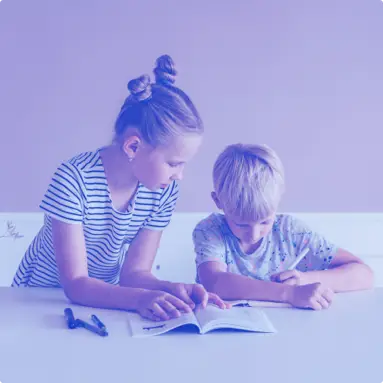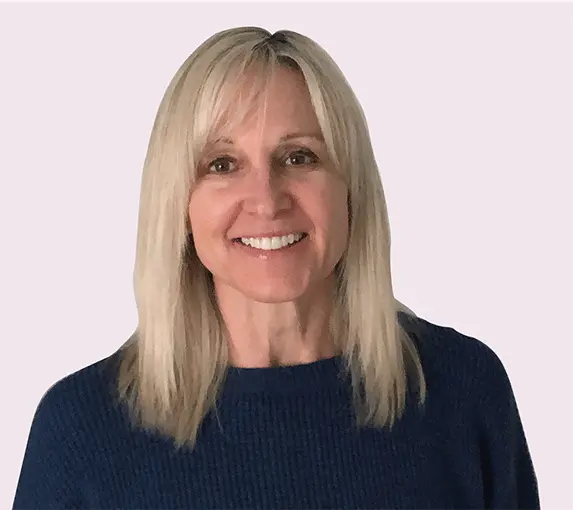
Episode 83: What makes a book beautiful: Behind the scenes of Editorial Production
Russian science, White space, and more. In this episode, Andy, Robin and Adam are joined once again by Geoff Turner, Head of Editorial and Production at Maths — No Problem! to discuss what details make a book beautiful. How important is layout? What team efforts have to take place? Plus, did you know the characters in the Maths — No Problem! books grow as the years go by?
More Podcasts on Education
Continue listening to our educational experts
Meet your instructors
The school of school podcast is presented by:

Andy Psarianos
@andy_psarianos

Adam Gifford

Robin Potter
Special guest instructor

Geoff Turner
Geoff is the Head of Production Editorial for Maths — No Problem! His team is responsible for the production of the mathematics textbooks and workbooks of the award winning
Never miss an episode
Subscribe to get the latest The School of School podcasts delivered to your inbox.
Podcast Transcription
Andy Psarianos
Hi, I'm Andy Psarianos.
Robin Potter
Hi, I'm Robin Potter.
Adam Gifford
Hi, I'm Adam Gifford.
Andy Psarianos
This is the School of School Podcast.
Speaker 5:
Welcome to the School of School Podcast.
Robin Potter
The Maths — No Problem! annual conference is back. Join us in London this November. World renowned speakers and experts will gather to discuss Maths Mastery in the post-
pandemic world. Be part of the conversation. Visit mathsnoproblem.com for details.
Andy Psarianos
Okay, welcome back everyone to another episode of The School of School Podcast, and today I'm really excited because not only do we have the regular crew, Adam, say, hi, Adam.
Adam Gifford
How you doing?
Andy Psarianos
And Robin, say, hi, Robin.
Robin Potter
Hey. Hey.
Andy Psarianos
But we also have Geoff Turner, and Geoff is a very valued member of the team at Maths — No Problem! So Geoff is the guy who is largely responsible for putting all the books that we do together.
So Geoff, why don't you give us a bit of an intro and tell us what you actually do?
Geoff Turner
Well, thank you for having me on, Andy, Adam and Robin. It's good to be here. So yeah, as Head of Editorial Production at Maths — No Problem! I head a team of five people who have a mixture of skills. So an Art Director, an Illustrator, a Design Support and a Production Editor. There is a little bit of overlap between some of those skills, believe it or not. Between us, we are responsible for the design and the layout and the creativity side of things in our books. And talking about our books, they are absolutely wonderful books to work on, and I have worked on thousands of books, so I'm very happy to be here.
Andy Psarianos
So what makes Maths — No Problem! books so exciting to work on for you, Geoff?
Geoff Turner
Well, as I said, I've worked on thousands of books, and that is across so many subjects. The very first book I ever worked on was called Polymer Science. You may think, okay, that's the usual science text, if you like, the odd illustration with cells, that sort of thing, but there was a little bit of a twist in the tail for a young Geoff Turner back in the day, in that this book was translated from Russian. I didn't have to do any of the Russian translation, thankfully. However, all the illustrations of the cells and the bonds and that sort of thing, I had to match them up with the translated text and I had to tag where these were going. I thought what have I let myself in for? It was obviously a task that nobody else wanted to do, so I remember that one. That was a nice introduction to some science books.
But over the years, I was thinking today that the one series of books that was the nearest to what we do was a series called McMillan Africa Primary Series. So we did some work for McMillan, a series of books over varying subjects for school children in Africa. So much fun, those books. Nothing like the other books I'd been working on to that date. It wasn't just about I'm turning from page five to page six and here's a new spread, it was there's new things to see, there's new characters, there's characters walking in a village with fruit and water and that sort of thing. And on certain books that were about mathematics they were doing sums.
Those are the type of books that you want to work on, like what ours are, where they are engaging. It's not just about the text on the page that is the learning or the pedagogy, it's about the illustrations, it's about the layout, it's about the space. So when somebody picks up a book nobody is thinking about the space in a book. They are thinking about what's the text here and does the illustration support the text? I can't go on holiday and read a book because I don't read the text. I look for the space. I look for the layout. I look for where the illustrations are. I can't enjoy reading, and that is the downside of my profession in that I can't read a book.
Robin Potter
You need audio books. You're definitely a candidate.
Geoff Turner
I do.
Andy Psarianos
I think it's one of those things that's highly underappreciated, the amount of craft that goes into the narrative of a story. And for us, a story is usually in lesson, in that is there's a beginning point, where effectively you are working with an unknown, what does the child know? What does he understand? But at the end, regardless of where their starting point is, you need to bring everyone to the same point in their journey, which is an understanding of the topic that you're discussing.
Being able to empathise a child's experience, looking at a couple of pages and working their way through it and how they will interpret that, is a real craft. It's a real skill. It requires a tremendous amount of understanding of use of space, for example, and understanding what eye flow looks like, and understanding where certain bits of information need to appear so that they appear in the child's mind at the right journey. Really, it's every lesson is a story and the authors obviously work very hard to get that right, but then it's easy to destroy it in the page layout.
So Geoff, can you talk a little bit about what are some things that when you're looking at a page and you're evaluating is this page actually working, what are some of the things that you look for? And how do you know what works and what doesn't work?
Geoff Turner
So you may remember we did a project last year where we got off on the wrong foot with that project and-
Andy Psarianos
Oh, I remember that.
Geoff Turner
And a few more of us got involved in that project. The first time I saw some of the spreads from what had been done up to that point I was absolutely aghast, because I was, "What year group is this aimed at?" The page was so busy it was almost like every single piece of content we had we were just going to throw at these pages. So getting back to what I said before, it's about the space as well. So if somebody is learning it's a process.
Your eye, anybody's eyes, will work in the same way going through a page. Certain things will stand out, of course, illustrations and so forth. But if you are reading a book you will work from the top to the bottom, and on these particular pages my eyes didn't know where to look. I was in the top right hand corner. I was in the bottom left hand corner. I was, where do I start? There's an element here that I should read. It says, do you know? Or something like that, should I read that first? And that sort of thing, when my mind gets too busy looking at a page then I know it's not right. It needs to be calm and concise and reflective of what we're actually aiming for. And I just thought how could anybody learn from that? Obviously we backtracked and we applied a different style, which was a little bit more in keeping with our brand style. And the books look fantastic now, so we did the right thing.
Andy Psarianos
So going back to the question, what are some of the...
Geoff Turner
Sorry.
Andy Psarianos
Yes. Okay. That's all right. No, but it's a great story.
What are some of the elements that you... So we're talking about space, What do you mean? Why is space important? We're talking about white space on the page when we say space, right?
Geoff Turner
Yeah, white space.
Andy Psarianos
Why is the white space important?
Geoff Turner
The white space is important because whenever you are reading a book you need time to think about and process what you're actually reading and what you are looking at, and if there is no white space then how can your brain do that breathe, if you like? Right, now's the next sentence, or now's the next paragraph, or the next question, or something along those lines. Where's the next thing I need to learn or thing I need to read? And that is the beauty of our books in that there is a flow to them. You can easily see where you need to be reading and what is relevant to that question or that line of text.
The space is vitally important for that reason. Yes, you can have too much white space and I think a page that has too much white space then the interest levels tend to go down a little bit. If you have a half page, or maybe just a page with a couple of questions at the top, you now need to rethink what has went on in the pages before? Can we fill that page? Can we do something so it's more in keeping with the fuller pages previous to that? So I am looking at books from that angle where it's about the space, the alignment, the consistency. But the consistency, you need to be very careful with consistency, because if you do too much consistency in layout it can also become a little bit technical, rule based. And as I said, some people outside of our skill set may not identify those things, but I see those things.
Robin Potter
Do kids have a different need for white space, or more, or less than adults? Do you know that?
Geoff Turner
I would say that over Year 1 books you should find more white space in those books versus what you would find in Year 6. You would expect the children have developed in such a way that they can cope with more things going on on a page by that point.
Adam Gifford
I think what's quite interesting, Geoff, and I do want to ask a question about your team. I'm going drop it in now just because I don't want to put you on the spot. A little bit of consideration, and that is what sort of considerations each one of your team make? And I don't know if there's any examples where they've gone, I've seen this and we need to change it to this for this reason?
But just jumping on that point that you were making there about the impact it has on children, I've been fortunate that I've worked with at least hundreds, I don't know, might be even thousands, I don't know, but a lot of children with these books. The one thing I've never heard is the children just saying, "Oh, the characters are cute." Or, "The pictures are cute." It's always, "This is helping me with my maths." Not those exact words, but what you tend to find is that when children talk about what they see on a page, any given thing, they will relate it back to maths. They will relate it back to how it supports them. So I think that speaks volumes, because if it was just this is a cute book, well cute is great, but cute doesn't necessarily teach maths, right?
And I think these considerations, I'm so pleased you've got an opportunity and I'll shut up to so we can hear more of what you do. I think it's really important people understand this because when people just think children's books are simplistic, oh, just throw a few cute characters at them and there you go, you've done it, box ticked, you go and sell it in schools. We're a million miles away from that.
So coming back to my original question, Geoff, I just wondered in your team the types of things that they might be looking for, the kind of individuals, and how they might change certain things just to give the people listening to the podcast a bit of an idea about the level that we go to try to make sure that we are doing as much as we can to support children's learning, which is ultimately what we do.
Geoff Turner
Yeah, sure. And one of the things you touched on there, Adam, I think there's almost a subconscious engagement in our books, in that they are so appealing visually that children want to learn from those books. And the depths we go to that people wouldn't actually see just from the book, the levels of attention we go to, is a little bit surprising at times. So for example, on our books we have 12 primary characters in our books and those 12 characters have a supporting cast of characters. So you'll have 12 children, very identifiable. We have them in various rotations. We have them in two different age groups, if you like. So we have them as Years 1 to 3, and then we have them as Years 4 to 6. So the 4 or 6 characters have longer arms and longer legs, and these sort of things I do wonder how many people would actually notice that sort of thing going on in our books.
On top of that, we have a community of characters, in that we have professionals. Obviously, we have scenes and openers to lessons where there is things going on with our favourite characters, and there is also a balance there in that those scenes can't be too intricate. They need to be very clear in what we actually... Strengthening the question, if you like, or the questions, with a good intro saying, yeah, we are all over that. So that is something that it did take me a little while to get into because I've never seen this before anywhere else where there's a community of characters. I don't know whether any of you know of some programmes that used to be on UKTV years ago, which was Trumpton and Camberwick Green, and that sort of thing?
I see our characters in a similar way to that where there's things going on, and my team may create a scene or something like that, and I'm saying, "Andy, Adam, write a question that will really support this illustration. I want everybody to see it." That sort of thing. And it brings the whole thing to life. And it gets back to what I was saying earlier about turning the page and actually, wow, what's going on here? There's a great scene here. Let's read the questions and find out what we're going to learn about. What's going on in this scene. There's a farm, there's eggs, there's chickens, that sort of thing. I mean, who wouldn't want to work in amongst that sort of thing?
Andy Psarianos
I think one of the things that we don't think about too much is kids start with these books at a very young age and then they're there usually for their entire primary journey. So they will see them for a long time, and they get to know the characters, and they get to know the characters' families because the characters' families appear here and there and, oh yeah, Ravi's got a, is it a sister or a brother? They know and they know what their parents look like and they identify with these characters. And when you go to classrooms and you do lesson observations and you maybe get an opportunity to talk to some of the children, you realise how important these characters actually are to them and how big of a part of their lives it actually is, right? It's like they see these characters every day for an hour. They're with these characters on a journey together.
They will remember them. They'll be talking about them, just like you probably remember, some kids... If you went to school in the U.K. you're probably still talking about Biff and Chip. If somebody says Biff and Chip, you know exactly what they're talking about, because you probably read those books and you know all the stories, and all that kind of stuff. These characters are that important.
So yeah, we put great care in. It's a respect. It's a respect to the children, and their needs, and their experiences, and the diversity of characters. Making sure that there's characters that everyone can identify with, that represent people that they will know and meet in their communities, and having all those kinds of things addressed. We put a tremendous amount of care in that. I'm sure we don't get it 100% right, but it's really important.
Robin Potter
And like you say, Geoff, that the kids can relate too, they're growing with the characters. I mean the characters are physically growing, as are the students. So each year the character's getting a little taller in the book and children are getting a little taller, and those are really important little details.
Andy Psarianos
Maybe Adam, can you talk through what role do the characters play in the book, other than just being nice little illustrations that the kids relate to?
Adam Gifford
Yeah, of course. Of course. I mean, they're absolutely key to learning. So we talk about developing metacognition, thinking for yourself when you're working with something. And often our characters will provide a prompt to make them think or relate to the content that they see on the page, so the characters aren't just there. I was saying earlier, Andy, they're not just there because it's cute and because it's nice, but they come up with some key ideas. They ask some really key questions that deepen that understanding with some of the more obvious representations on the page. They allow us to explore far more deeply.
I think, also for teachers, the one tool that I absolutely loved is that I could always refer to the characters. What does Charles think? What does Charles mean when he says this? Is it always the same number of coins? Is that true? Can we have different amounts of money? And even if so and so's got fewer coins does that mean that they've got less amount of money?
Whenever you look at a page, one of our pages, you could pick up anyone in our books, what I love about them, and you know you've done a good job if you can do this, is pick it up and then the following year get more from the same page, then get more from the same page, then get more from the same page. And the characters play a really key role in that. What's Charles thinking about when he says this? Is there anything else that we can explore around that? What else could he have said? Where are we looking when he sees this thing on the page? Well, you point it out to me. I don't know, you tell me. You and Charles, you're on your own. I'll help you.
And this is the sort of thing that you can do that the children, it becomes what they... It's habitual. It's part of their learning process. And so I think being able to come at it from these different avenues to have, if you like, a set of teachers that are in the book, a set of prompts that are in the book that children can relate to, as Andy said, and it fosters independent learning. They're a really key aspect in the book.
And that's what I think. I think that that's something that comes out loud and clear with the conversations that we have. And what you and your team do, Geoff, is when something looks simple and easy to understand I think we've nailed it, because the complexity that underpins it is massive, is absolutely massive. I just wish that more people were privy to some of the conversations and processes that go on with your team, with everyone in the company, because I think they'd be staggered. And I think that, like I said, we know we've done a good job when that page at the end looks relatively simplistic, but can keep on giving, and we can keep learning from it. And me, someone has used these books for years and years and years and knows them, I know you know these books pretty well, still get things from them, and still think with a teacher's head, I can get even more out of this page tomorrow.
I think that that's the thing that I just find staggering. But it's not staggering when you know what goes on, and you know the teams, and you know the conversations that they're having. And you and your team, I mean, geez, you make a lot of the work that I do, sing, absolutely sing, and it's a delight, and the kids win. So, I think it's amazing.
Andy Psarianos
Yeah, it's a real challenge, it's every element is so critical. So wherever the idea comes from in the author's mind you got to come up with some crazy manifestation of there's a particular topic that you're trying to address and you want a particular learning to happen. And then you've got to try to bring that to life somehow with a scenario, with a problem, then the solving of that problem. But all of that can be very, very easily destroyed by presentation. If it's not present, it won't work. It's like every single element needs to be carefully considered. And they don't only necessarily need to be considered simply in the one lesson or the one page, but the consistent elements that need to be consistent all the way through, so like, you talked about metacognition.
Metacognition is not a short game. You can't put one speech bubble with a character on one page and think, well, right. I've ticked off the metacognition thing, now that's dealt with. No, no. This is something that is carefully crafted very slowly from Year 1 all the way through to the end of Year 6, through a consistent systematic approach to transferring information graphically, and mathematically, academically, whatever you want to say, pedagogically, sound way, with a very clear intent. All those things need to come together in order for it to work really, really well, and it takes a huge cross section of skills and knowledge and understanding in many different disciplines to put it together.
Anyway, Geoff, we're so lucky we have someone who cares as much as you do on the team. People like you are not easy to find. People like Adam aren't easy to find. But when you put all this beautiful team together of people who care, and want to do the right thing, and are driven to create the best education products that have ever been made, it's like magic to see it in action, even with all the chaos, and when it doesn't work well, and all the corrections, and all the messiness that's involved in it.
Here's a funny thing, just to wrap this one up. So I was driving from Manchester to Swansea, as you do, working as a trainer back in the day when book 1A, textbook 1A, the first textbook 1A was printed, I got a call from the printer saying, "Books are done. Where do you want us to ship them to?" And I said, "Oh, can you send them here?" Then I got off the call and I cried. Isn't that something? At that point I recognised the achievement, like what we had actually done, and it had never been done before. No one had ever paid this much attention in a maths book, as far as I know. And we've continued to just up the ante and do better and better and better every year. I'm so proud of all of you guys, really.
Anyway, there you go. Thanks Geoff. Thanks for joining us.
Geoff Turner
No, thank you. It's a fantastic product we have.
Andy Psarianos
Thank you for joining us on the School of School Podcast.
More Podcasts on Education
Continue listening to our educational experts
